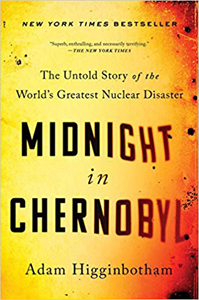 Adam Higginbotham, Midnight in Chernobyl: The Untold Story of the World's Greatest Nuclear Disaster (New York: Simon and Schuster, 2019), 561pp.
Adam Higginbotham, Midnight in Chernobyl: The Untold Story of the World's Greatest Nuclear Disaster (New York: Simon and Schuster, 2019), 561pp.
A review by Brad Keister, former Deputy Division Director of the Physics Division for the National Science Foundation.
Shortly after midnight on Saturday, April 26, 1986, the staff at Reactor Number Four at the Chernobyl Nuclear Plant near Pripyat, Ukraine, were conducting a test simulating a blackout power failure. The result was anything but routine: a steam explosion that exposed the nuclear core, leading to an open-air graphite fire that released fission products into the atmosphere that settled across the USSR and Western Europe. Hundreds, if not thousands, of people eventually died from radiation effects, and large swaths of land are not habitable to this day. The partial meltdown of the nuclear core came close to poisoning the water supply for most of Ukraine.
Researched meticulously by journalist Adam Higginbotham, this book is not a risk analysis for nuclear power (or any other energy source), but rather a chronicle of a culture of secrecy, misinformation and cover-up. For starters, this catastrophe was completely preventable. In its race to show itself superior to the US in reactor technology, high-level USSR technocrats designed massive reactors with little or no attention to standard design safeguards, and hid known flaws even from plant directors and engineers. The reactors were often constructed with shoddy materials and poor workmanship by crews who were given impossible deadlines to fulfill. The test protocol itself involved turning off whatever safeguards that the reactor possessed. During the test, politically sensitive supervisors ignored parts of the protocol. The recipe for disaster was well mixed — it was only a matter of time before a massive failure occurred.
But this time, the culture of secrecy failed — the facts were too widespread for the government to put the genie back into the bottle. The Western press had evidence of massive radiation on European soil and shouted, “What have you done?!” Inside the USSR, too many citizens knew of mysterious deaths and huge evacuations. The final outcome exceeded the scope of the catastrophe: many claim that the massive costs of cleanup, together with the loss of citizen trust, were major contributing factors to the breakup of the Soviet Union only a few years later.
A key lesson from this book is that truth cannot ultimately be contained and hidden. Higginbotham does a masterful job of showing how well-meaning (or not) characters become trapped in their webs of deceit. For some, the outcome might be considered just, but for most, it was tragic.
Dan Clendenin: dan@journeywithjesus.net


